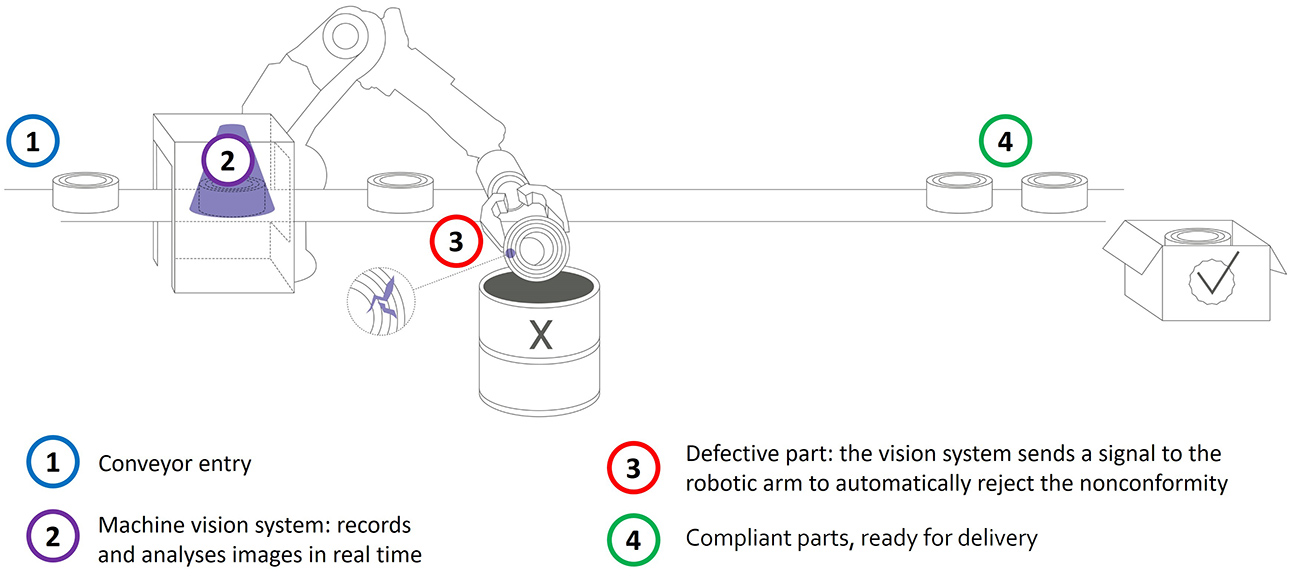Innovative manufacturers: Zero-defect production through machine vision
The new industrial age of innovative manufacturing promises to bring its share of state-of-the-art solutions to today’s challenges, from process control to quality control. With machine vision systems, the goal of zero-defect manufacturing is now within reach.
Digital technology as a vector for change
The digital transformation is sparking big changes in the manufacturing sector as we enter the fourth industrial revolution (Industry 4.0) or the age of innovative manufacturing. This transformation allows manufacturers to integrate new technologies to boost automation and, ultimately, improve process fluidity, production speed, and product quality control.
For example, it is now possible to roll out integrated process control systems that provide real-time measurements to assess the efficiency of each step in the production process and pinpoint problem areas so corrective actions can be taken. With robotics such corrections can increasingly be automated as part of the production line.
One of the challenges of control systems is their ability to detect errors or nonconformities. State-of-the-art detection tools are essential for collecting the information needed to make accurate, informed decisions. One popular detection method with a proven track record is machine vision.
What is a machine vision system and how does it work?
A machine vision system is made up of a sensor (often one or more cameras) and a light-delivery system. Modern technology makes it possible to capture images of each object directly on a moving conveyor (i.e., a 100% sample). The images are then transmitted to a computer loaded with real-time analytics software. Depending on the system and how it is used, the computer can perform a number of actions:
- Diagnose a problem
- Identify the source of a problem
- Trigger an automated response
- Assess the conformity of the part or product being analyzed
- Apply corrective measures based on the problem
The best vision systems are even capable of identifying the chemical composition of certain objects, an invaluable feature in applications used for sorting (e.g., recyclable materials). Precise analyses require powerful machine vision systems. Otherwise, the information captured will only be partial and thus unusable.
Although there are some outstanding commercial systems on the market, they are often not powerful enough for more complex cases. Having a custom solution in place at critical steps in the production chain provides compelling results and gives manufacturers a unique competitive edge over the competition.
Zero-defect production: A real-life example
Our client, a well-established Quebec auto parts manufacturer, already had an automated quality assurance inspection system in place to achieve zero-defect production. One type of part was particularly difficult to inspect due to its complex geometry and considerable variances in shininess. No standard systems were equipped to handle this specific need, so a custom machine vision system had to be developed.
Simplified diagram of the inspection system

Our client was extremely satisfied with the results:
“We developed a part inspection system with INO. The parts now leave our plants absolutely perfect. We’re talking zero defects. A remarkable feat!”
Richard Guimont, CEO of Liberty Spring
Custom solutions for innovative manufacturers
Machine vision is a key component of innovative manufacturing and production chain automation. In highly complex cases, a custom solution can drastically boost production chain performance. In such cases, INO’s expertise really pays off, because we work with you to develop a machine vision system tailored to your specific needs, whether for quality control or process control.
Ready to take your production line to zero-defect level? Looking for a custom sensor to help your industrial vision system meet client needs?
Visit our website and contact us to start or continue your transition to Industry 4.0.